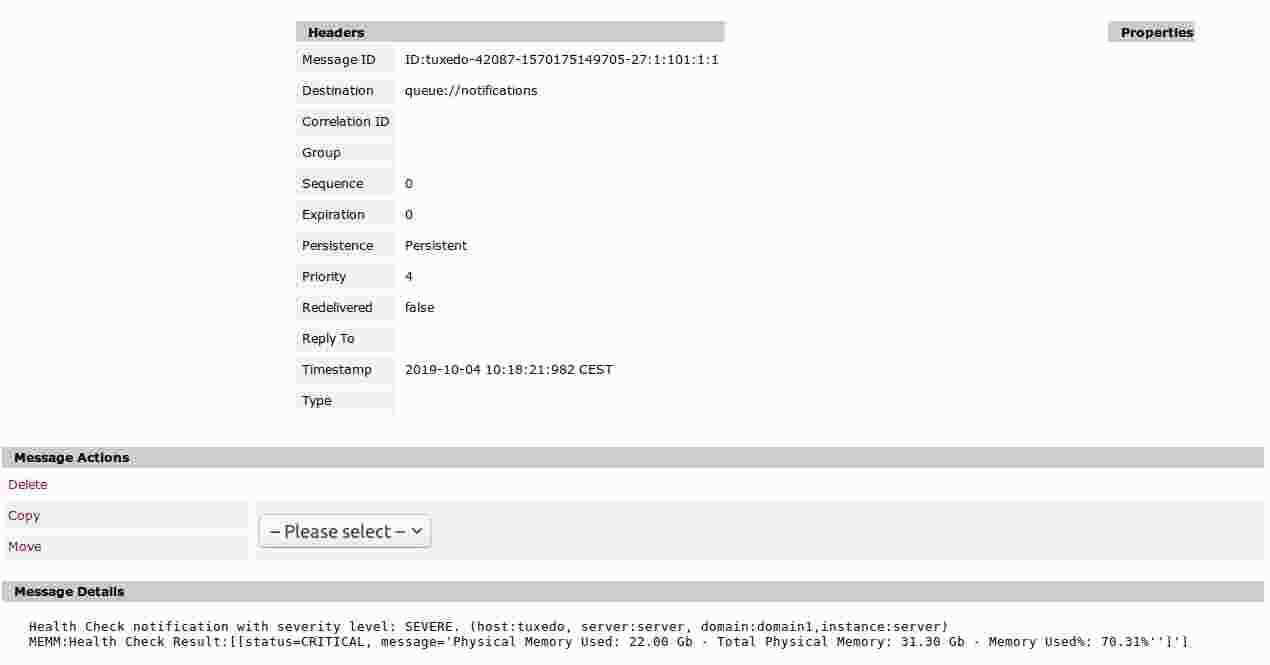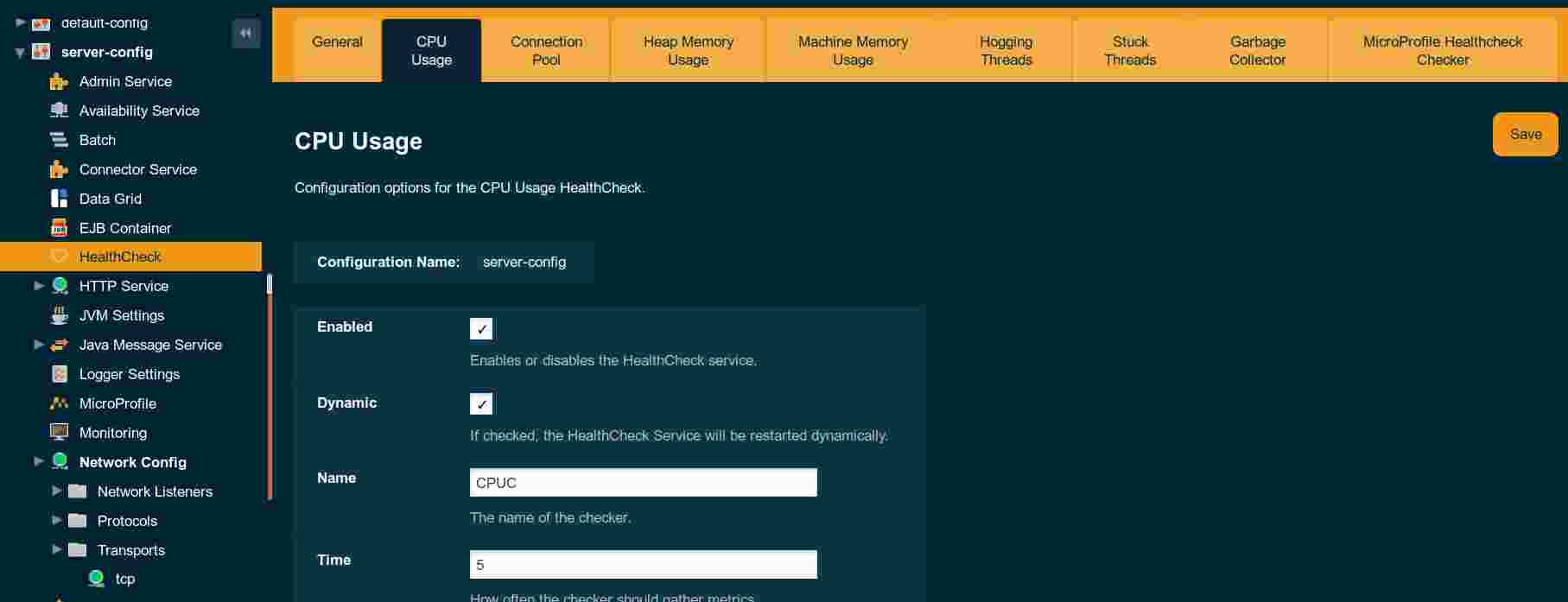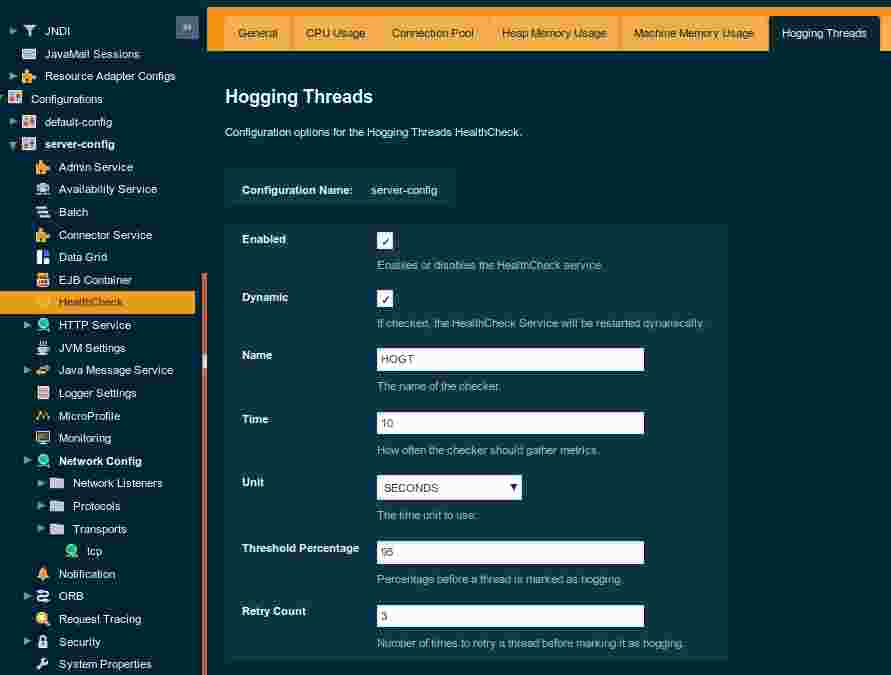The Health Check Service In-Depth - Payara Server 5
Originally published on 16 Oct 2019
Last updated on 16 Jul 2021
 by Ondro Mihályi
by Ondro Mihályi
This is an updated blog of the original which was published in May 2016
Payara Server provides the Health Check Service for automatic self-monitoring in order to detect future problems as soon as possible. When enabled, the Health Check Service periodically checks some low level metrics. Whenever it detects that a threshold is not met, it triggers alert notifications that allow to detect undesired behavior and predict possible failures. All of these automatic checks are very lightweight and run with a negligible impact on performance.
The Health Check Service periodically checks several metrics, such as CPU and memory usage. If any of these metrics exceed a configured threshold, then a notification message is sent through the Notification service to an appropriate notifier. The default Log notifier prints the message to Payara Server's log file with an appropriate log level. Other notifiers can process notifications further or forward them to external systems. When properly configured, this mechanism helps to rapidly detect problems or work out what happened after problems had occurred. It also provides enough flexibility to route the information about detected anomalies to external systems to store the information, process it and even attempt to heal some problems automatically.
For most of the checks, threshold configurations can be specified in 3 different levels: good, warning and critical. When the threshold is not met, the Health Check Service will trigger a notification with the level of Warning, Error or Critical respectively and will continue to do so periodically until the threshold is met.
This is how the notifications routed to the server's log file might look like in a log viewer: Or, if we enable a JMS notifier, the Health Check notifications will also end up in a JMS queue. Here is how a message would look like in an ActiveMQ broker's queue:
Or, if we enable a JMS notifier, the Health Check notifications will also end up in a JMS queue. Here is how a message would look like in an ActiveMQ broker's queue:

The Health Check service functionality is available in the core Payara Platform and therefore also in Payara Micro. It can be configured in both Payara Server and Payara Micro using the same asadmin commands. Payara Server also provides Admin Console to configure everything using a web UI.
Let's Get Started: Enable the Health Check Service
The Health Check Service is not enabled by default. It can be easily enabled in Payara Server's Admin Console, in the HealthCheck configuration page:

You can also enable it using the asadmin set-healthcheck-configuration command:
asadmin> set-healthcheck-configuration --enabled=true --dynamic=true
The argument --dynamic=true is necessary to turn on the service for a running server, otherwise it would only be applied after a server restart.
We can check the actual configuration of the Health Check Service and all its metrics using asadmin get-healthcheck-configuration:
asadmin> get-healthcheck-configuration
This is an example output from the above command, after some Health Check services have been configured:
Health Check Service Configuration is enabled?: true
Historical Tracing Enabled?: false
Name Notifier Enabled
SNMP false
CDIEVENTBUS false
EMAIL false
SLACK false
EVENTBUS false
JMS false
NEWRELIC false
LOG true
XMPP false
HIPCHAT false
DATADOG false
Below are the list of configuration details of each checker listed by its name.
Name Enabled Time Unit Threshold Percentage Retry Count
HOGT true 10 SECONDS 95 3
Name Enabled Time Unit Critical Threshold Warning Threshold Good Threshold
CPUC true 10 SECONDS 90 70 50
GBGC true 10 SECONDS 80 70 50
HEAP true 20 SECONDS 80 70 50
MEMM true 5 SECONDS 80 70 50
Command get-healthcheck-configuration executed successfully.And this is an example of log messages produced by the above configuration:
Health Check notification with severity level: INFO - MEMM:Health Check Result:[[status=GOOD, message='Physical Memory Used: 18.40 Gb - Total Physical Memory: 31.30 Gb - Memory Used%: 58.80%'']']|#]
Health Check notification with severity level: INFO - MEMM:Health Check Result:[[status=GOOD, message='Physical Memory Used: 17.80 Gb - Total Physical Memory: 31.30 Gb - Memory Used%: 56.88%'']']|#]
Health Check notification with severity level: INFO - MEMM:Health Check Result:[[status=GOOD, message='Physical Memory Used: 17.91 Gb - Total Physical Memory: 31.30 Gb - Memory Used%: 57.21%'']']|#]How to Configure Monitoring of Individual Metrics
In order to configure the Health Check service to monitor a specific metric, a service for that individual metric must be configured first.
The HealthCheck page in the Admin Console contains a tab with configuration for each individual service, e.g. for CPU Usage:

Individual services can also be configured using the asadmin set-healthcheck-service-configuration command:
asadmin > set-healthcheck-service-configuration --service=<service.name> --enabled=true --dynamic=true --time=<time value> --time-unit=<time unit enum>
--threshold-critical=90 --threshold-warning=50 --thresholdGood=0All of the services accept a configuration of the time interval, in which the Health Check for that service is evaluated. The --time argument specifies the number portion of the time. The --time-unit argument specifies the unit which is a string representation of any unit from the TimeUnit Java enum.
The name of each Health Check service is listed in the Payara reference documentation for the set-healthcheck-service-configuration command. Here are the names for the currently available services:
"stuck-thread"or "st"-detects all requests that block threads for too long"mp-health"or "mh"(MicroProfile Health) - detects MicroProfile health endpoint status"connection-pool"or "cp"- tracks how much is a connection pool utilized"cpu-usage"or "cu"- tracks how much is the CPU utilized- "
garbage-collector"or "gc"- tracks the number of garbage collections - "
heap-memory-usage"or "hmu"- tracks the amount of heap memory used "machine-memory-usage"or "mmu"- tracks the amount of RAM used"hogging-threads"or "ht"- detects threads that consume a lot of CPU
You can use both the long name and the short variant as the value of the --service argument.
For example, to configure the frequency of executing the health checks for the CPU usage to be every 5 minutes, we would run the following asadmin command:
asadmin > set-healthcheck-service-configuration --service=cpu-usage --time=5 --time-unit=MINUTES --enabled=true --dynamic=true The same command can also be used to configure the thresholds:
set-healthcheck-service-configuration --service=cpu-usage --enabled=true --dynamic=true --threshold-critical=90 --threshold-warning=45 --threshold-good=20Note that it's possible to list all the Health Check services with the list-healthcheck-services command. However, this command prints service names that are not valid for set-healthcheck-service-configuration command. They are valid for older asadmin commands which are now deprecated. We plan to change the output to match the new service names in the future.
Monitoring of CPU and Memory Metrics
The Health Check service offers 3 services that check resource usage:
- CPU Usage
This service calculates how much the Payara server JVM process has utilized the CPU within the monitoring interval and prints the average percentage and the total amount of time in milliseconds that the CPU was used by the Payara server. - Memory Usage
This service queries the total amount of physical memory available to the machine, the current amount of memory being used and calculates the percentage of memory usage. - Java Heap Usage
This service queries the initial amount of memory requested for the Heap space, the current amount being used, the current amount being committed (available for future use) and the maximum amount of memory available to be used for the Heap space and calculates the current percentage of memory usage for the Heap.
For all three of these metrics, the service will run periodically and it will compare the calculated values (% of use) to the threshold configuration values (GOOD, WARNING and CRITICAL) and issue alerts in the standard logging mechanism configured for the domain.
The following table summarizes the boundaries for each alert severity:
| Lower Boundary (Including equal) | Upper Boundary (Not equal) | Result |
| 0 | GOOD-Threshold | No event is logged |
| GOOD-Threshold | WARNING-Threshold | GOOD event logged |
| WARNING-Threshold | CRITICAL-Threshold | WARNING event logged |
| CRITICAL-Threshold | 100 | Critical Event Logged |
For example, if the CPU usage service calculates the value of 21.8%, with these thresholds in the configuration
- GOOD: 20
- WARNING: 45
- CRITICAL: 90
then a GOOD notification will be triggered. If the Log notifier is enabled, an INFO message similar to this one would be written to the server's log file:
[2019-10-03T11:03:19.460+0200] [Payara 5.193] [INFO] [] [fish.payara.nucleus.notification.log.LogNotifierService] [tid: _ThreadID=122 _ThreadName=payara-executor-service-scheduled-task] [timeMillis: 1570093399460] [levelValue: 800] [[
Health Check notification with severity level: INFO - CPUC:Health Check Result:[[status=GOOD, message='CPU%: 21.08, Time CPU used: 201 milliseconds'']']]]
Note that the INFO log level corresponds to the GOOD Health Check event.
Detecting Misbehaving Threads
The Health Check service provides services to detect suspicious behavior of threads used within Payara Server. These allow to detect the following types of misbehaving threads:
- Hogging threads - all running threads that are "hogging" the CPU in a Payara Server domain. The checker computes the percentage of CPU use for each active thread with the ratio of elapsed CPU time to the checker execution interval and compares this percentage to a preset threshold value. In case the current percentage exceeds that value, a CRITICAL message event triggered for each detected thread.
- Stuck threads - all threads that are used to process a request but were not released before the threshold time elapsed. This is mostly caused by a deadlock or a request taking too much time to complete.
To configure how the threshold for hogging threads is evaluated, the Hogging Threads service offers the following 2 parameters:
hogging-threads-threshold: Defines the minimum percentage needed for the thread to count as being hogged CPU-wise. The percentage is calculated with the ratio of elapsed CPU time to the service execution interval. Its default value is 95.hogging-threads-retry-count: Represents the number of times the service should detect the same hogged thread in order to trigger health check notifications for that thread. Its default value is 3.
These can be configured in the Hogging Threads tab in the Admin Console:

And again, the set-healthcheck-service-configuration command can be used to configure these parameters too:
asadmin set-healthcheck-service-configuration --service=hogging-threads --enabled=true --dynamic=true --hogging-threads-threshold=95 --hogging-threads-retry-count=3The Stuck Threads service threshold is also configured by special parameters:
stuck-threads-threshold- the minimum time since a thread was claimed to process a request after which it's considered stuckstuck-threads-threshold-unit- the time unit for the threshold
These can be configured in the Stuck Threads tab in the Admin Console and also using the set-healthcheck-service-configuration command as well.
Monitoring GC Activity
The garbage collection Health Check Service checks periodically for any garbage collections. It calculates and prints out how many times garbage collections were executed within the time elapsed since the last check. The log messages include the following information for both young and older generation garbage collection types:
- number of GC executions since last check
- total time spent in GC cycles
- name of the garbage collector algorithm
- severity (status) of the message
For this service, it's also possible to set the standard GOOD, WARNING and ERROR thresholds. The value for the threshold is calculated based on the amount of the GC activity.
Monitoring of JDBC Connection Pools
The connection pool health check service checks how many connections in a JDBC connection pool are used and how many remain free. If the ratio of used connections hits the configured thresholds, it will print an appropriate alert message to the log. If there are multiple connection pools being used, the alert will include information about all of them.
Monitoring the Metrics Defined by the Application
Payara Platform allows applications define custom health checks using the MicroProfile Health API. The results of these checks are normally available via an HTTP endpoint. With the MP Health service in the Health Check service, it's possible to detect an unhealthy status reported by this HTTP endpoint periodically and trigger notifications in the same way as with other Health Check services. Moreover, this service will monitor these Health HTTP endpoints of all the server instances in the Payara domain and trigger notifications if any of them reports unhealthy status.
Once you enable the MP Health service in the Health Check service, no further configuration is needed. The service will automatically scan all available MicroProfile Health endpoint in the configured interval and will trigger notifications for the following HTTP responses:
- HTTP 200 (OK) - notification of type GOOD, the service reports healthy status
- HTTP 503 (the endpoint is unreachable) - notification of type WARNING
- HTTP 500 (unhealthy status reported) - notification of type ERROR
More Information
We intended to give you a thorough overview of what the Health Check Service provides and how all the monitoring metrics can be configured. For more information, you can always refer to the HealthCheck Service documentation page, which provides up-to-date information and will keep being updated when new metrics are added in future versions of Payara Server.
The Health Check service is also available in Payara Micro edition. You can configure it using asadmin commands in a post boot command file. Refer to the Payara Micro documentation about using the post boot command file.
Related Posts
Securing Jakarta EE Application Servers Needs Executive Attention
Published on 10 Sep 2025
by Asif Khan
0 Comments
Why Java Developers Need to Help Their CTO Prioritise Security in 2025
Published on 26 Aug 2025
by Asif Khan
0 Comments
%20Application%20Servers-An%20Executive%20Guide%20Cover.jpg?width=500&name=Securing%20Jakarta%20EE%20(Java%20EE)%20Application%20Servers-An%20Executive%20Guide%20Cover.jpg)
